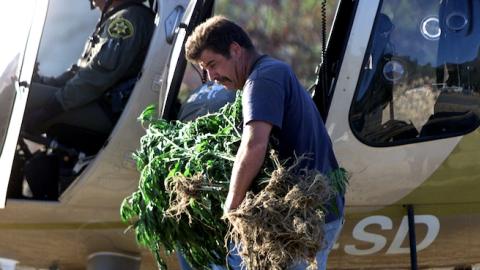The Washington Post’s Christopher Ingraham on Thursday returned to a flawed thesis first reported back in May. Ingraham argues that marijuana smuggling nationwide is dropping, an effect of legalization in states like Colorado, Washington, and Oregon. Because the drug is commercially available, illicit forms of the drug have fallen from favor. As a result, smuggling has declined.
To make the argument this time around requires taking on the Drug Enforcement Administration (DEA), which released a June report arguing to the contrary. According to the DEA, marijuana smuggling is increasing, citing residential commercial grows in Colorado as the problem. The marijuana is then “shipped out of Colorado and sold in markets where it commands a high price.”
Ingraham’s argument relies on a United States Sentencing Commission report, and a graph purportedly showing a steep decline in smuggling beginning in 2012 and continuing through 2015. He titles the graphic “Marijuana Trafficking Declines.”
Ingraham appears to have missed something. What the graph actually shows is not criminal trafficking activities, but rather the decline in the number of people sentenced for federal trafficking offenses. While smuggling is a criminal behavior, sentencing rates reflect political decisions—the relationship between them is indirect.
If one no longer aggressively arrests, prosecutes, convicts, or sentences crimes of drug trafficking, sentencing will go down independent of the underlying behavior.
There are ways to test these two arguments. First, we should ask whether the downturn in sentencing is specific to marijuana. The Commission’s report shows that federal sentencing for cocaine/crack trafficking offenses has also fallen, just as marijuana sentencing has, but without any state having legalized cocaine/crack as they have marijuana.
Conversely, in spite of widely-noted increases in the production, trafficking, and use of heroin, causing sharp spikes in overdose deaths since 2010, sentencing for heroin trafficking has not proportionally increased.
Both of these examples imply that it is changes in law enforcement and judicial priorities under this Administration that are driving sentencing numbers, and not changes in the underlying commission of crimes.
But for a final counter example, we would not conclude that there have been dramatic improvements in the threat America faces from drug trafficking during this last week, even though the number of federal drug trafficking prisoners, including armed felons, fell by 214 persons in but a single day.
Rather than improvements in crime rates, we surely recognize that commutation, a political act by the President, is the cause of this decline.
Whatever the effects of drug legalization, declines in nationwide drug trafficking are not among them.














